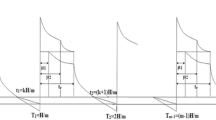Abstract
This paper emphasizes upon inventory model possessing two warehouses. The same includes matters which hold degrading aspect, and the very model has been developed with exponentially diminishing order rate with limited suspension price including salvages. The particular model beholds one rented warehouse where another one is inherent. The degrading rate feature of inherent warehouse exhibits linear function of period and the degradation of rented house delivers a persistent function. Salvage value is calculated on own warehouse. The objective of this study is to find total appropriate inventory cost and which should be reduced. The usefulness of the aforesaid model as well as the sensitivity investigation of the finest resolution corresponding to a mixture of features has been observed considering a mathematical illustration into account.
Similar content being viewed by others
Change history
28 September 2023
A Correction to this paper has been published: https://doi.org/10.1007/s42979-023-02168-3
References
Abad PL. Optimal Pricing and lot sizing under conditions of perishability and partial backordering. Manage Sci. 1996;42:1093–104.
Aligu I, Soni B. An inventory model for deteriorating items with generalized exponential decreasing demand, constant holding cost and time-ranging deterioration rate. Am J Oper Res. 2018;8:1–16.
Bhunia AK, Maity M. A two warehouse inventory model for deteriorating items with linear trend in demand and storages. J Oper Res Soc. 1998;49:287–92.
Dave U. On the EOQ model with two level of storage. Opsearch. 1988;25:190–6.
Dye CY, Ouyang LY, Hsich TP. Deterministic inventory model for deteriorating items with capacity constraint and time-proportional backlogging rate. Eur J Oper Res. 2007;178(3):789–807.
Goyal SK. EOQ under conditions of permissible delay in payments. J Oper Res Soc. 1985;36:35–8.
Hartly RV. Operation research—a manegerial emphasis. California: Goodyear Publishing Company; 1976. p. 315–317.
Kaliraman NK, Raj R, Chandra S, Chaudhary H. Two warehouse inventory model for deteriorating item with exponential demand rate and permissible delay in payment. Yugosl J Oper Res. 2017;27(1):109–24.
Lee C, Hsu S. A two warehouse production model for deteriorating items with time dependent demand. Eur J Oper Res. 2009;194:700–10.
Lee C, Ma C. Optimal inventory policy for deteriorating items with two warehouse and time dependent demands. Prod Plann Control. 2000;11:689–96.
Ouyang LY, Wu KS, Cheng MC. An inventory model for deteriorating items with exponential declining demand and partial backlogging. Yugosl J Oper Res. 2005;15(2):277–88. https://doi.org/10.2298/YJOR0502277O.
Sahoo NK, Sahoo CK, Sahoo SK. An EOQ model with two parameter constant deterioration and price dependent demand. Int J Ultra Sci Phys Sci. 2009;21(2):M515–520.
Sana S, Chaudhuri KS. A stock-review EOQ model with stock dependent demand, quadratic deterioration rate. Adv Model Optim. 2004;6(2):25–322.
Sarma KVS. A deterministic order level inventory model for deteriorating items with two storage facilities. Eur J Oper Res. 1987;29:70–3.
Shah NH, Shukla KT. Deteriorating inventory model for waiting time partial backlogging. Appl Math Sci. 2009;3(9):421–8.
Yanlai L, Fangming Z. A two warehouse inventory model for deteriorating items under conditionally permissible delay in payment. Appl Math Model. 2011;35:2221–31.
Zhou Y. A multi-warehouse inventory model for items with time–varying demand and shortage. Comput Oper Res. 2003;30:509–20.
Zhou YW, Yang SL. A two warehouse inventory model for items with stock-level-dependent demand rate. Int J Prod Econ. 2005;95:215–28.
Author information
Authors and Affiliations
Corresponding author
Additional information
Publisher's Note
Springer Nature remains neutral with regard to jurisdictional claims in published maps and institutional affiliations.
This article is part of the topical collection “Computational Statistics” guest edited by Anish Gupta, Mike Hinchey, Vincenzo Puri, Zeev Zalevsky and Wan Abdul Rahim.
Rights and permissions
Springer Nature or its licensor (e.g. a society or other partner) holds exclusive rights to this article under a publishing agreement with the author(s) or other rightsholder(s); author self-archiving of the accepted manuscript version of this article is solely governed by the terms of such publishing agreement and applicable law.
About this article
Cite this article
Sahoo, C.K., Paul, K.C. & Kumar, S. Two Warehouses EOQ Inventory Model of Degrading Matter Having Exponential Decreasing Order, Limited Suspension in Price Including Salvage Value. SN COMPUT. SCI. 1, 334 (2020). https://doi.org/10.1007/s42979-020-00346-1
Received:
Accepted:
Published:
DOI: https://doi.org/10.1007/s42979-020-00346-1




